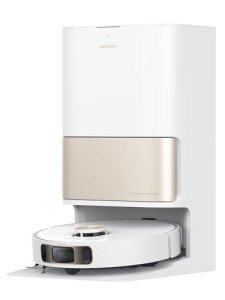Five Killer Quora Answers To Robotic Vacuum Cleaner Best
페이지 정보

본문
 What Makes a Robot Vacuum Cleaner Best?
What Makes a Robot Vacuum Cleaner Best?The most effective robot vacuums feature a powerful engine and a robust set of bristles or rollers. They also have large dustbins and an extended battery life.
Certain models map homes with smart mapping. They can stop to recharge, and then clean up where they stopped. They can set up zones that are not allowed to enter, and can recognize different surfaces.
Object Avoidance
Object detection is an essential feature for robot vacuums as it allows them to avoid hitting small objects such as socks, shoes or toys, or even cords that aren't found on the floor robot, but instead on furniture or other things. The systems utilize an inbuilt camera to detect objects that are in an AI database, and then teach the vacuum to avoid them. The Eufy S1 Pro, for example, uses a combination of sensors including 3D Time of Flight (sending light pulses to determine the distance and depth of surrounding objects) and 3D Structured Light (beaming a pattern of light onto the room and analyzing the light distortion to build an image) to efficiently steer clear of obstacles.
Artificial intelligence and visual interpretation are a newer addition to robot obstacle avoidance. They enable robots to understand and recognize what they come across. This software uses one or two cameras to view the world around them and then analyzes it in real-time. The ECOVACS DEEBOT uses this software to detect up to 30 different kinds of objects such as cables, shoes, and pet poop.
Certain models also employ LiDAR to navigate. This technology emits lasers and determines the amount of time it takes to bounce off surfaces in order to create an 3D map. This is helpful in detecting walls, furniture and even stairs. It might not work in low light or with reflective or transparent objects.
Whatever cameras or sensors are employed it is crucial that your robot has a long-lasting battery to be able to complete a home without having to return to the dock for recharging. Pick a model that has a battery life of at least 80 minutes or more, depending on the size and shape of your home.
Self-Emptying Bases
Some robot vacuum cleaners feature self-emptying bases, which could reduce the frequency with which you need to empty your dustbin. They're considered to be a luxury feature, and usually add to the cost of a robot.
The most effective robots have bases that hold either bins or a movable dustbin. It is possible to open it and empty it when full. This can save you time by cutting down on the time spent worrying about when to empty a dustbin.
Self-emptying bases are present on all the robots featured in our review, with the exception of the bare-bones Roomba I3+, which doesn't have a self-emptying base. This is a shame, as this robot is otherwise an extremely strong performer. It got the best results in mapping of all the robots we tested and it has excellent navigation capabilities. It also has a good mowing power and a docking station that can automatically empty the water tank when needed.
It's not equipped with iRobot's innovative obstacle avoidance or digital keep-out zones it can get tangled over cables and rugs and can't see rogue socks and shoelaces. However, it's an excellent option for an apartment that is small and well-maintained.
Other strong points are its navigation system, which includes bump sensors and drop sensor, and the ability to create a map of your entire home by using lasers and cameras. It's also easy to set up, offers many settings and modes, and also offers an excellent performance in mowing and vacuuming. Its smart-home feature allows it to be controlled by voice commands using Amazon Alexa or Google Assistant. This can make it easier to operate if you own multiple tablets or smartphones and don't wish to purchase a traditional remote.
App Controls
Certain robots come with Wi-Fi connectivity that allow users to control them from your tablet or smartphone. This is especially useful in homes with several floors. It is possible that you will need to navigate down a staircase to reach the robot before it is able to reach the bottom. It also removes the requirement for a long cord, which means you can move furniture around without having to worry about your robot getting caught in the cord or running out of power while cleaning.
The app serves as a one-stop control center for monitoring and scheduling tasks. The app lets you modify your robotic cleaner's power, cleaning modes and water level settings. This feature is especially useful in homes with different flooring types -- for instance, carpet or tile, as you can assign the robot to clean each area with the appropriate power and mode.
Certain models have an inbuilt camera that can send live feeds to the app. These models are a great choice for pet owners or those with children who need to keep an eye on the robot as it works. smart vacuum cleaner robots also use sensors to know when they've reached the edge of a space, and then return to their docking station. This prevents them from overrunning the area and also ensures that they've cleaned all of the surfaces in your home.
Certain models can empty the dustbin automatically and even wash their mop heads and blow dry them between cleaning sessions. This will reduce the requirement for manual maintenance and the robot cleaner will work better for a longer time. You can also choose one with a longer battery life which will help you avoid the hassles of mid-cleaning recharge.
Sensors
Many robot vacuums are equipped with sensors that let them navigate through your home. They can work on area rugs, carpets, and hard floors like wood and tile. They are not a replacement to an upright or full-size canister cleaner, but provide superior suction and a great way to keep your floor clean in between deep cleanings.
Sensors help the robot navigate your home by spotting obstacles and avoiding falling down steps. They also allow you to set virtual and physical "no-go" zones by using the feature known as boundary strips or virtual walls (like the ones used by Eufy) to prevent the robot from entering specific areas of your home. Certain robots also come with cliff sensors, which warn you when the robot is close to crossing an edge.
The kind of navigation system that the robot uses depends on your budget and layout of your home. Some of the most advanced robotic vacuum cleaner vacuums utilize LiDAR-based sensors to scan and map rooms, ensuring accurate and efficient navigation. These systems are costly however they deliver the best results. Models that are budget robot vacuum-friendly with basic navigation bumps are less precise and Robotic vacuum cleaner best may miss areas. These models are adept at getting around obstacles, but they can fail to spot dirt in crevices and around baseboards.
Look for a model with an extra-large dust container and a long battery lifespan. You can also find models that recharge and resume the same place they left off after they dock to save time. In addition to navigation and cleaning, you can get the most out of your robot vacuum by preparing for each cleaning session. Make sure that power cords as well as toys and other debris are removed and out of the robot's path, and empty the bin between each cleaning. Clean the charging port and sensors to ensure that your robot is healthy.
Navigation
The most effective robot vacuums employ mapping technology to create an electronic map of your home during the initial cleaning session. It helps them to recognize textures such as hard or carpeted floors and ensures that all areas are cleaned. It also prevents your robots from having to clean the same areas again and can increase efficiency and decrease battery consumption. Many high-end models allow you to save maps to be used in the future. This is great for large homes.
Most robotic vacuum cleaner Best vacs have some kind of obstacle avoidance, which stops them from running into shoes, cords or socks. These sensors are not always able to detect smaller items. Manufacturers started adding sensors to robots a few years ago. This allowed them to detect and avoid household objects that traditional sensors could not. These include wall and cliff sensors, which operate by bouncing infrared light beams off of surfaces to determine distances.
Some of these sensors are built into the robot's base, while others require a separate attachment. These sensors aid the robot to move safely and avoid falling off steps, and keep away from clutter. Some models have anti-drop sensors which prevent the robots from hitting furniture and walls.
LiDAR mapping, the most advanced navigation system, is a feature you should look for when buying the robot vacuum. The system makes use of an ejector that spins on the robot to map your home. By scattering infrared beams across furniture and walls it is able to determine the layout of your room. This information helps it plan efficient routes and clear your entire home.
- 이전글What's The Current Job Market For Budget Robot Vacuum Professionals Like? 25.03.01
- 다음글Buy UK Drivers License: The Good, The Bad, And The Ugly 25.03.01
댓글목록
등록된 댓글이 없습니다.
